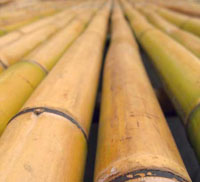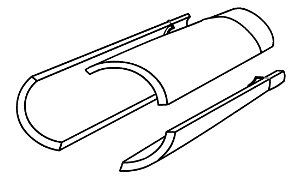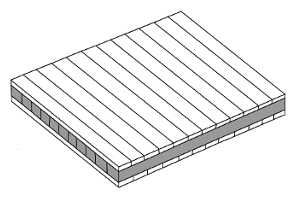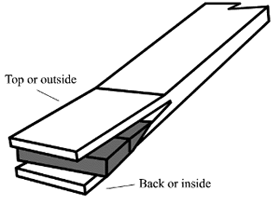Bamboo Boatbuilding
Bamboo is a material with excellent engineering qualities that has so far been useful to boatbuilders mainly as a source for spars. In this article, Richard Emmet proposes processing bamboo for marine plywood.
I held a sample of interior grade bamboo ply in my hand and it took less than two seconds to decide that I could build boats out of this stuff. I could not believe how light it was! And it felt about as stiff as steel. Of course it has to be completely incased in epoxy to be used in a marine application and the interior bamboo ply is not, but bamboo has a lot of merit, none the less.
Bamboo has strengths comparable to hardwoods with weights (depending on species) between 19 and 24 lbs per cubic foot. Bamboo is a rapidly renewable resource; Moso bamboo is mature in 5 ½ years, compare that with Douglas fir which takes 60 to 80 years to reach maturity. I hope someone starts manufacturing marine grade bamboo ply panels soon.
All of the bamboo I’ve seen has been processed the same way. They cut the bamboo radially and produce thin pieces about half an inch wide. Then they square them up and glue it in a matrix.
The raw material itself would be very difficult for an amateur or one-off boat builder to use because the builder would have to glue a zillion pieces together. This method could be used by manufacturers to produce marine grade bamboo ply panels similar to interior grade bamboo ply panels (using epoxy). However, I believe for most applications the panels would be too stiff. The individual pieces of bamboo are often over a quarter of an inch thick. How would one bend a sheet of ply made from this stuff over a boat frame with complex curvature? Bamboo is so stiff that a bamboo spatula I have will hardly bend even though the thickness is only 4 mm. Pieces of bamboo like those shown above could be used to manufacture marine grade bamboo lumber (glued with epoxy). This could be used by boat builders to fashion ribs and other framework in a boat.
My thinking is that we need raw materials that an amateur or one-off builder could use in several different ways. I’ll get to that in a minute, but let me start with how the bamboo should be processed.
Bamboo Processing
Moso bamboo - Take a variety of giant bamboo like Moso and cut it radially but in fewer pieces. Moso bamboo has a diameter up to approximately six inches and a circumference of approximately 19 inches. Instead of cutting it in 12 or 15 pieces, cut it in three or four pieces.
Cutting the culm - Each piece will form an arch somewhere between about 4 ½ to about six inches wide. The culms taper as do trees; the width of each piece will vary and will have to be trimmed as the material is processed.
Three pieces from one culm - The pieces will have to be cleaned up, as there is a lot of material on the inside of the culm at each node. Once cleaned up the, pieces will then be either soaked or steamed to make them flexible.
Splitting the slats - Then the pieces will be fed into a machine that will temporarily flatten them and split them into at least two pieces. Flattening the bamboo may induce stresses into the material that would not be welcomed in any finished product, but I believe that splitting the material will relieve the stresses. The thinner the bamboo is split (if splitting the material in more than two pieces) the more stress will be relieved.
The pieces will then be dried - they must be kept flat so that at the end of this stage of the process, there will be bamboo slats of various widths and lengths. Bamboo has a natural variation of mechanical and physical properties (strengths) from the inside to the outside wall. So there will be different grades of bamboo slats as well.
The sawmill - The slats will then be milled to fairly standard widths (perhaps three to four inches) thus providing a product that can more easily be used by one-off or amateur builders. Of course the slats could be used by the manufacturer to produce bamboo ply or other products. Bamboo ply panels could incorporate other materials in the matrix.
There are several ways I think boat builders would want to work with the slats of bamboo, depending on the application, the amount of curvature and the structural requirements. As I said before, bamboo is extremely stiff and it may be very difficult to bend panels in more than one direction. Having various grades of bamboo slats to choose from will allow for more flexibility in application. More flexible bamboo panels could be used where there is more curvature and stiffer bamboo panels could be used in bulkheads for instance.
The bamboo panels could have a face (or top layer) of “top” or “face” grade bamboo while the core and back layers could be made up of lower grade “back” or “inside” bamboo. Varying the grade and / or the thickness of each layer would give you a very wide variety of qualities of bamboo panels. For some plywood chine boats, one could use bamboo ply panels made entirely of “top” or “face” grade bamboo where there would be little curvature and where a very rugged boat is desired.
One of the benefits of having bamboo slats three to four inches wide commercially available is that builders using the constant camber method could produce their own marine grade bamboo panels very quickly and potentially end up with a much lighter and more robust structure. Again extreme stiffness may be a problem here, but one idea is to use another material in the core of the panels. For example, one could use western red cedar as a core material and bamboo on the face and back. Such panels would work well for decks also; a thick core of western red cedar would be only slightly heavier than the bamboo (per cubic foot) and would provide excellent insulation from heat and noise.
Bamboo Block and Veneers
There are other ways to produce marine grade bamboo ply panels and at this time veneers of bamboo are being manufactured by taking those small pieces of bamboo, gluing them into blocks and then cutting the bocks to the desired thickness. This could be useful to boat builders if the manufactures would glue the pieces together with epoxy. However, you would end up with only one “lower” grade of bamboo ply panel. There will be some variation of the quality from veneer to veneer depending on where in the block it was cut from. Remember, bamboo has a natural variation of strength and stiffness from the inner to the outer wall.
This may be a little hard to see, but the illustration above shows bamboo pieces being glued into a block and then veneers being cut from the block. The striation of colors in the resulting veneers illustrates the variation in strength of each veneer. Making ply panels from these veneers would produce a somewhat lower quality product without having the option for other grades.
Buy first flattening and then cutting each slat of bamboo, one could have tighter quality controls and a variety of grades that the customers could choose from depending on the intended application. Please feel free to comment or correct me if you have specific knowledge of wood products or of process engineering or naval architecture for that matter.
Thanks to Rick Emmet for the submission!






